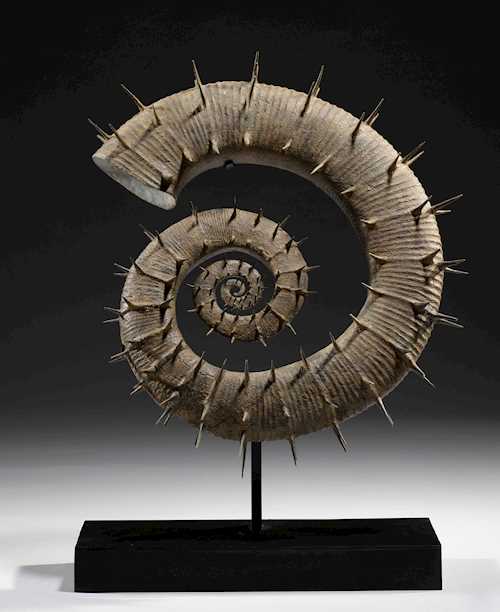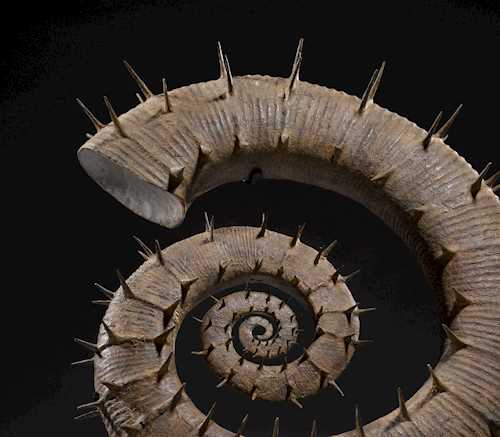
Lot 1813* - S17 Out of This World - Tuesday, 28. June 2022, 04.00 PM
SPINY AMMONITE
Crioceras Nolani
Alpes de Haute-Provence, France
Cretaceous, Hauterivian, 129-132 million years
35 x 34 x 6 cm
Alpes de Haute-Provence, France
Cretaceous, Hauterivian, 129-132 million years
35 x 34 x 6 cm
Provenance: Italian private collection
Ammonites are an extinct group of cephalopods that were very rich in form. There are 1500 known genera of ammonites. Thanks to their variety of forms ammonites are a popular collector's item. Their shell - rolled up in the manner of a logarithmic spiral - recalls that of a snail, but this is not the case with all ammonites. The species Crioceras Nolani has a flat, spiral shell, where no coil is in contact with the other. Why this shape developed in this way is unknown. Possibly this species lived in the benthic zone at the lowest level of the sea, so there was no need for a shell suitable for swimming in this species. The spines decorating the animal's shell served as protection for the ammonite, which was either sedentary or could only move slowly on the sea floor.
The specimen presented here has wonderful and long spines and is a masterpiece of modern palaeontology.
刺菊石
Crioceras Nolani 羊角菊石上普罗旺斯的阿尔卑斯山, 法国白垩纪,Hauterivian,1.29至1.32亿年前35 x 34 x 6 厘米
菊石是一种已经灭绝的头足类动物,形状繁多。已知的菊石有1500个属。由于形状多样,菊石是一种受欢迎的收藏品。大多数时候,它们的外壳类似于对数螺旋形式的蜗牛,但并非所有菊石都如此。Crioceras Nolani物种有一个扁平的螺旋形外壳,没有螺纹与另一个螺纹接触。为什么会出现这种形状尚不清楚。可能该物种生活在海底的底栖区域,所以不需要适合游泳的壳。装饰在动物外壳上的刺起到了保护菊石的作用,菊石要么是定居的,要么只能在海底缓慢移动。这里所展示的标本有着美妙而狭长的刺,是现代古生物学的杰作。
CHF 10 000 / 15 000 | (€ 10 310 / 15 460)
Sold for CHF 17 380 (including buyer’s premium)
All information is subject to change.



